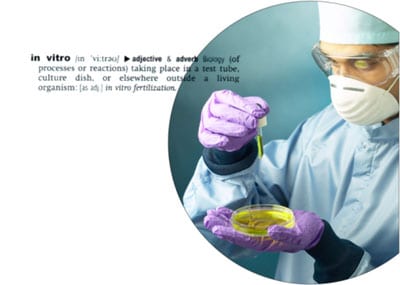In vitro fertilization is common option for couples facing fertility problems. Performed at licensed fertility clinics and by licensed physicians, the method involves several steps. The process involves ovulation induction, egg retrieval, fertilization and implantation of embryos into the uterus.
Definition
In vitro fertilization, or IVF, is a method of fertilizing a woman’s egg with a man’s sperm outside the woman’s body. This process of fertilization takes place in a laboratory of a certified fertility clinic. After fertilization, the egg is implanted into the woman’s uterus. If successful, pregnancy results. Couples who are experiencing difficulties in conceiving a child can opt for this procedure to start their family.
Ovulation Induction
In vitro fertilization is not a quick process. Prior to the actual egg retrieval, the woman has to go through ovulation induction. This is a procedure that involves injecting hormones into the woman to stimulate egg development. It usually takes 10 days of hormonal injections before the ovaries start producing more eggs. Normally, a woman produces only one egg during ovulation; with stimulation, there are more. With ovulation induction, the ovaries can produce as many as 20 eggs.
Egg Retrieval
After determining that there are enough eggs produced, the eggs are retrieved. This is a process performed in the clinic to extract or remove the eggs from the ovaries. There are two possible ways to collect the eggs; one is by needle insertion through the vagina and the other is by incision in the abdomen. In the first method, after inserting the needle through the vagina, the doctor will extract the eggs by inserting the needle into the ovary, and then the doctor aspirates or suctions the eggs. The eggs are immediately transferred to a Petri dish. With the incision method, the doctor inserts a needle through the incision and removes the eggs from the ovaries by aspiration.
Fertilization
Fertilizing the eggs, also known as embryo culture, consists of mixing the eggs with sperm on a Petri dish that contains a medium suitable for fertilization. Injecting the sperm into each egg with the aid of a microscope can help speed up the fertilization. It is important that clinicians monitor the progress of the fertilization. The object is to get at least one egg fertilized. It takes about 2 to 5 days for the zygote to form.
Implantation
About 2 or 3 days after fertilization, the clinician chooses the healthy embryos that will be transferred into the woman’s uterus. Another method is the blastocyst transfer. In this method, after 5 days of culturing, the embryos reach the blastocyst stage (embryos consisting of 100 cells), making it easier to choose the healthy embryos for transfer into the uterus.
Implanting the embryos into the uterus involves loading a catheter with the embryos and passing it through the cervical opening up to the middle part of the uterine cavity. There is no pain involved and the procedure requires no sedation or drugs. During the procedure, the woman should have a full bladder in order to allow good ultrasound visualization, which helps to transfer the embryos to the best location possible. When the catheter tip reaches the desired location, it squirts out the embryos to the lining of the uterus. Next, the clinician removes the catheter and checks it under the microscope for any retained embryos. If there are any leftover embryos in the catheter, the clinician quickly repeats the process and then checks the catheter again for any retained embryo. Most clinics transfer one to two embryos into the uterus, which increases the likelihood of pregnancy. This may result in some women conceiving multiple babies if all of the embryos implanted survive.
There is a new type of infertility treatment known as frozen embryo transferis or cyropreservation. Patients may choose to freeze any embryos left after the procedure in order to use them if the first batch of embryos fail to develop.
Risks
There is an increase in the chance for high order multiple births and development of ovarian cysts with the use of ovulation induction medications. Some of the side effects that can occur include pelvic, abdominal and chest pains. Some women may experience nausea, vomiting, weight gain and difficulty in breathing when experiencing ovarian hyperstimulation syndrome (OHSS). For more details on the effects of ovulation induction, read the article “Ovarian Epithelial Dysplasia after Ovulation Induction,” published by Oxford Publication in September 2008 (click the link under Resources).
Cost
In vitro fertilization is not cheap; depending on the procedures involved, number of attempts before successful fertilization, birth delivery charges (normal or Caesarean), single or multiple births, it ranges from $ 66,000 to $ 240,000 as of 2009. The majority of health insurance policies do not cover IVF. However, in cases where there is a combination of procedures, such as surgical procedures combined with IVF, the insurance policy may cover the surgical procedure or the birth delivery. For infertility alone, most insurance companies will not provide coverage.





